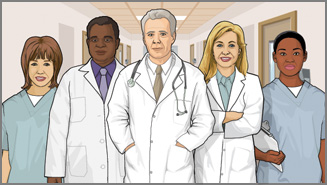Health exams for: #AGEGROUP#
The following exams, tests, and procedures are recommended for #AGEGROUPLOWER#.#FEMALETEXT#
Select a link from the list below to learn how and why each test is performed, as well how to prepare for it.

The following exams, tests, and procedures are recommended for #AGEGROUPLOWER#.#FEMALETEXT#
Select a link from the list below to learn how and why each test is performed, as well how to prepare for it.
The brain is composed of more than a thousand billion neurons. Specific groups of them, working in concert, provide us with the capacity to reason, to experience feelings, and to understand the world. They also give us the capacity to remember numerous pieces of information. There are three major components of the brain. The cerebrum is the largest component, extending across the top of the head down to ear level. The cerebellum is smaller than the cerebrum and located underneath it, behind the ears toward the back of the head. The brain stem is the smallest and is located under the cerebellum, extending downward and back toward the neck. The cerebral cortex is the outside portion of the cerebrum, also called the “gray matter”. It generates the most complex intellectual thoughts and controls body movement. The cerebrum is divided into left and right sides, which communicate with each other through a thin stalk of nerve fibers. The grooves and folds increase the cerebrum’s surface area, allowing us to have a tremendous amount of gray matter inside of the skull. The left side of the brain controls the muscles on the right side of the body and vice versa. Here, the left side of the brain is highlighted to show the control over right arm and leg movement, and the right side of the brain is highlighted to show the control over left arm and leg movement. Voluntary body movements are controlled by a region of the frontal lobe. The frontal lobe is also where we shape emotional reactions and expressions. There are two parietal lobes, one on each side of the brain. The parietal lobes are located behind the frontal lobe towards the back of the head and above the ears. The taste center is located in the parietal lobes All sounds are processed in the temporal lobe. They are also important for learning, memory, and emotion. The occipital lobe is located at the back of the head behind the parietal and temporal lobes. The occipital lobe analyzes visual information from the retina and then processes that information. If the occipital lobe becomes damaged, a person could become blind, even if his or her eyes continue to function normally. The cerebellum is located at the back of the head underneath the occipital and temporal lobes. The cerebellum creates automatic programs so we can make complex movements without thinking. The brain stem is located underneath the temporal lobes and extended down to the spinal cord. It is critical for survival because it connects the brain with the spinal cord. The top portion of the brainstem is called the midbrain. The midbrain is a small portion of the brain stem located at the top of the brain stem. Just below the midbrain is the pons, and below the pons is the medulla. The medulla is the part of the brain stem closest to the spinal cord. The medulla, with its critical functions, lies deep within the head, where it is well-protected from injuries by an extra-thick section of overlying skull. When we are asleep or unconscious, our heart rate, breathing and blood pressure continue to function because they’re regulated by the medulla. And that concludes a general overview of the components of the brain.
Review Date: 4/27/2023
Reviewed By: Linda J. Vorvick, MD, Clinical Professor, Department of Family Medicine, UW Medicine, School of Medicine, University of Washington, Seattle, WA. Also reviewed by David C. Dugdale, MD, Medical Director, Brenda Conaway, Editorial Director, and the A.D.A.M. Editorial team.


